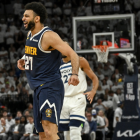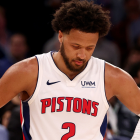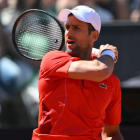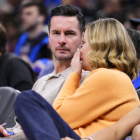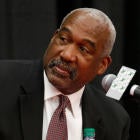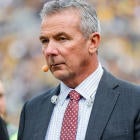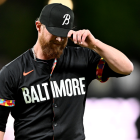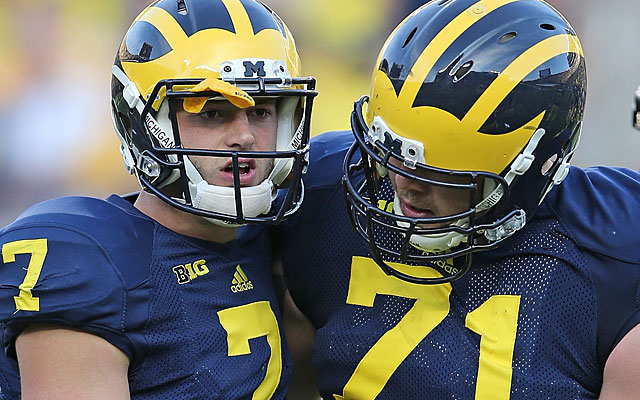
Facing increased scrutiny over the handling of injured quarterback Shane Morris, Michigan coach Brady Hoke on Monday defended his actions and suggested Morris only has a "high ankle" injury.
When asked at a news conference whether Morris has been diagnosed with a concussion, Hoke replied, "Everything that I know of, no." Hoke said Morris has a high ankle sprain and could have practiced Sunday if not for the ankle injury. According to Hoke, Morris told him he stumbled into the arms of a teammate after a hit to the head because his ankle gave out.
The fundamental question being asked in the medical community: Was quarterback Shane Morris medically cleared to return to the Wolverines' 30-14 loss to Minnesota with apparent concussion-like symptoms, or was this a coach's decision? The issue also places scrutiny on the NCAA's new concussion guidelines, which are not enforceable rules, at a time when lawsuits are trying to be settled.
Hoke would not say whether Michigan's medical department went through proper concussion protcol, saying a statement will come later from medical officials. Hoke maintained that it is not his decision to provide clearance for a player to re-enter a game.
Video shown by MGoBlog.com is pretty chilling. First, Morris gets leveled on a hit to the head that could have been called targeting to warrant an automatic ejection. Morris gets up, wobbles around, and only stays on his feet by leaning on offensive lineman Ben Braden.
The Michigan Daily, the university's student newspaper, reported that tight end Khalid Hill motioned for Morris to go to the sideline. Also, running back Justice Hayes signaled to the sideline for medical assistance to come on the field and offensive coordinator Doug Nussmeier called for Morris to fall to the ground so his injury could be assessed, the newspaper reported.
Morris waved everyone off. In his postgame news conference, Hoke said, "I don't know if he had a concussion or not, I don't know that. Shane's a pretty competitive, tough kid. And Shane wanted to be the quarterback, and so, believe me, if he didn't want to be he would've come to the sideline or stayed down."
That's the old-school culture that people in the concussion community say needs to change among players and coaches. Players often minimize their symptoms because they want to stay in the game, placing the onus on others to make the decision on their behalf. Two Division I quarterbacks have quit this season after sustaining multiple concussions.
At the very least, Hoke essentially said he did not know how to identify obvious signs of an apparent concussion to trigger doubt about a player's health. It's not clear what transpired on the sideline. Football is a frenetic game and chaos can occur on a sideline. Michigan could have called a timeout to evaluate Morris immediately or sent out another player. Yet that part of the situation, as odd as it was, still wasn't the most questionable decision.
Morris was taken out after running one more play. A short time later, new quarterback Devin Gardner had to leave the game by rule because his helmet came off during a play. Third-string quarterback Russell Bellomy scrambled to find his helmet to enter the game, but Morris was sent back into the game instead.
On Monday, Hoke said he talked with the referee about wanting to take a timeout so Gardner could stay in the game.
"When I talked to the referee -- because he kind of came to the sideline -- and he said, 'No,'" Hoke said on MGoBlue.com. "So, a couple seconds later the line judge comes up and says, 'Now, you can buy a timeout.' But by that time, Shane was already back in the football game.
"[Shane] was on the bench and [senior football athletic trainer] Paul Schmidt was looking at his leg, and [reserve quarterback] Russell Bellomy was there. Russell is signaling in, him and the other quarterbacks. And when Shane heard his name, the medical staff said, 'Yeah, he can go.' And he went out on the field. We'd never put a kid out there who wasn't capable. He was medically cleared to go in on that play."
At his news conference Monday, Hoke said, "I knew the kid had an ankle injury. That’s what I knew." Hoke said when Morris gestured to the sideline that he was fine, "that tells you something. ... We would never, ever, if we thought a guy had a concussion, keep him in the game, and never have."
When asked why Morris still had his helmet to return to the game for a play, Hoke said "he hadn't been diagnosed yet" and referred to a future statement from Michigan's medical department.
The Michigan situation highlights a criticism of the NCAA's new concussion guidelines released this summer: How can the guidelines be enforced? Even if the NCAA determined that Michigan mishandled Morris' situation, it's not clear what, if anything, the NCAA could do. Schools and the NCAA have been fearful of liability issues by putting in enforceable requirements.
Under terms of a proposed settlement in several concussion class-action lawsuits, the NCAA executive committee would recommend that Division I, II and III pass legislation requiring member schools to certify they have a concussion management plan that meets the settlement's requirements. One requirement is prohibiting athletes from returning to competition on the same day they are diagnosed with a concussion. That's a basic guideline that has been understood in the medical community for years.
The new NCAA guidelines say that the team medical director and primary athletics health care providers must have clear and transparent authority when caring for injured players. Last year, the Chronicle of Higher Education reported 53 of 120 surveyed athletic trainers/staff members said they had felt pressure from football coaches to return a player faster than what was medically needed.
Michigan has highly qualified medical officials to evaluate concussions. Team neurologist Jeffrey Kutcher, hired by Michigan's athletic department in 2011, is considered one of the leading concussion experts in the world. Kutcher has been a consultant for the NBA and NHL and testified before Congress about head injuries.
A message left with Kutcher on Monday was not immediately returned. A request with Michigan to speak with Michigan athletic director Dave Brandon and athletic department medical officials has been unsuccessful.
In response to CBSSports.com's request for Michigan's concussion management protocol, the athletic department sent the NCAA's 11-page document for treating head injuries. One sign of a possible concussion listed on the NCAA document: balance problems.
NCAA chief medical officer Brian Hainline declined to comment Monday about how Michigan handled the situation. Hainline has been in communication with Michigan officials and said his understanding is the university will be clarifying what happened.
“My primary concern with all of these events is there’s a good medical team in place and the communication is in place so independent medical care is always followed at every junction,” Hainline said.
Hainline, who is a neurologist, said the NCAA continues to discuss the possibility of turning its concussion guidelines into legislation -- a point the NCAA made when releasing the guidelines this summer. The NCAA has said the guidelines could change as science evolves.
But the larger question is how to enforce concussion management if it's rules, not simply guidelines.
Hainline said the best enforcement mechanism could be a group of people reviewing concussion-related issues each week and making recommendations on discipline. He compared the idea to how a group of conference officiating coordinators evaluate targeting penalties each week.
“I could see something like that happening, and have a mechanism in place to report incidents,” Hainline said.
Hainline said if an NCAA enforcement system exists for concussions, it needs to cover all of the NCAA rather than a two-tier system that caters to public perception.
“It’s an impossible task and you’re going to end up policing the high-profile sports,” he said. “I don’t see a way of having like a police or monitoring every possible thing. You have to be fair and say we’re not just looking at the televised games. You have to look at the 97 percent of other games going on, too. Those kids are at as much risk or not more.”
Ramogi Huma, executive director of the National College Players Association, said the Michigan situation highlights inaction by the NCAA and Big Ten and the need for independent concussion experts on the sideline with the power to pull a player.
"Coaches are too caught up in the game, they're too caught up in winning," Huma said. "There's a conflict of interest. We shouldn't leave that to the discretion of a coach who's paid millions of dollars. What Coach Hoke did is not even against NCAA rules. If that player stumbled off the sideline half conscious and got paid $10 for signing an autograph, the NCAA would have made sure he wasn't allowed back into the game."
Huma has been leading efforts for Northwestern football players to form a union and be legally declared employees.
"What independent doctor in America would have put that player back in the game?" Huma said. "Not one. But Michigan did. That is a problem. It could be life or death. We saw with (former Frostburg State football player) Derek Sheely. The same thing happened, but the public didn't see it. Coaches kept him in practice and he's dead. This is life and death."
Hoke said it's fair to criticize his coaching, but not his concern for the well-being of players.
"There should be criticism when we talk of the performance and that’s me, that’s coaching. I understand that," Hoke said. "But when your integrity and character is attacked, I think that’s really unwarranted."













